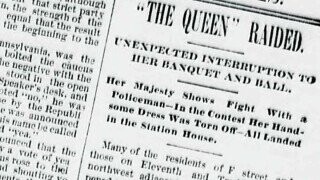How A Former Slave Became Our First Drag Queen

Most comfort food TV game shows have a dark history if you go back far enough. If you like the inviting, creative atmosphere of The Great British Bake-Off, you might want to avoid learning literally anything about how professional kitchens work. If you’re the kind of nerd who loves Antiques Roadshow, then you might not be able to resist learning how much of the antiques industry is built on lies and frauds that have lasted centuries longer than any old tchotchkes.

And on the same lines, if you follow RuPaul’s Drag Race, you should take some time out to remember that drag wasn’t always so easy to enjoy. It was illegal in the US for decades, and it’s still a one-way ticket to garbage people's shit list in too many ways to count here. But every time you join in with a cheer of “yas, queen” or “work that stuff," you’re honoring all the queer and trans activists who worked for decades to make drag culture socially acceptable.
But all that history, the good, the bad, the ugly, and the fabulous, had to start somewhere. That’s why we’re here to tell you about William Dorsey Swann, who was born a slave and wound up becoming the first person to be called a drag queen.
Don't Miss
Dorsey Swann (a name that already sounds like a drag persona, so he had a bit of a head start on most queens) was born into slavery in Maryland less than a year before the Civil War broke out. We can’t tell you much about his childhood since it’s hard to find records of any freed slaves, let alone six-year-old ones, but he wound up in Washington, DC -- the seat of government, a perfect spot for a future queen.

But just in case today's queer kids needed another reason to love Swann, the earliest records we have on him consist of being gay and doing crime. In his early 20s, he was working as a janitor at a business school in DC and got arrested for stealing a huge load of plates, silverware, and other party supplies from the school. What kind of party was he planning on throwing? A drag ball, of course!
There isn’t exactly detailed paperwork that lets historians delve into secret underground cross-dressing clubs, so they have to do some guesswork -- after all, we’re talking huge ball gowns and corsets, not bikinis, so they left a lot to the imagination. But we know that the parties Swann threw were mostly for other young Black men and that they borrowed a lot of party planning ideas from earlier covert celebrations during slavery, where part of the whole idea was both making fun of the rich white people and getting to enjoy rich white people stuff.

If that sounds familiar, it’s the same basic concept behind camp and burlesque and all the rest. It didn’t start with Swann, but he was one of the first people we know who brought it all together with the “maybe I’m not a man who’s into women” thing.
How did one man pull all that off? To start with, he was already one charismatic bastard. Remember that charge of stealing the party supplies? As it turns out, he was such a smooth operator he got his bosses to send a personal letter to the justice system, asking them to pardon him for the crime.
We don’t know if their request succeeded, but we do know that’s the level of criminal mastermind stuff you don’t even see in mystery stories. Planning the perfect crime in a whodunit is one thing but, “This guy dunit, we still love him so much we want him back from prison” is another.

With that kind of supernatural charm, Swann wasn’t just in charge of getting the supplies for the drag balls; he was the star of the show. His dresses were so elaborate, so expensive, and regal that he was always the center of attention. He became a pillar of the secret little community, and people started calling him “the queen of drag.” Michael Jordan was still about a century away from being born, so no one was going to call him “the Michael Jordan of drag," but it was pretty much the same sentiment.
But, like any queen, Swann got charged with defense of the realm, and literally charming the pants of people can only take you so far. In 1887, the Washington police began raiding drag parties. The Queen was always the biggest and most obvious target, for all the reasons we’ve been talking about. Swann ended up in multiple brawls with police officers, which ended with his famous dresses in tatters.
After a raid on his house on New Year’s Eve of 1895, Swann was officially arrested and got slapped with the charge of “running a disorderly house," which is the official language for the law against running a brothel. In case you’re curious, having a literal disorderly house was fine -- it was never a crime to be a lazy slob. But either way, calling these parties brothels shows just how hard it was to just be outside the demands of society back then since you would be labeled a filthy sex freak in the eyes of the law just by existing.

If you look into the official writing on the subject, people didn’t even know how to talk about what Swann and his friends were doing: One psychologist called the drag dance “an organization of colored erotopaths” and “debauched beyond pen power of description," which makes them sound like the Power Rangers of sex.
Swann fought back against the conviction through official channels. He filed a legal complaint arguing that since there wasn’t any law on the books against what he was doing, he was being framed. Of course, he was talking to people who saw him as a pervy monster, so the official response from the legal system was, “Exactly, that’s what makes it so bad, now take off that dress and put on these handcuffs." Even a failed effort made history, though: It’s the earliest example we can find in the United States of an official legal complaint about LGBTQ+ discrimination.
That means Swann wasn’t just the first drag queen; he was a pioneering activist too. It must have taken a ton of confidence to go out and publicly argue in favor of the stuff he’d been keeping on the DL for years. But you know what else takes a ton of confidence? Putting on a ballgown and getting everyone to call you the Queen. Once you’ve done that, what difference does the law make?

All things must come to an end, but for Dorsey Swann, the end was just the beginning. When he retired from the Washington drag scene around 1900, his brother Daniel took over for him and presided over the scene for more than half a century. Daniel was probably the one who helped establish “drag queen” as a term that applied to more than one person -- he established the succession, you could say.
And just like Logan Roy’s succession, the departing Queen left behind a whole empire. There were drag communities like Swann’s in big cities all across America, and Swann’s extravagant style had spread from the country’s capital, much like Five Guys would a century later.
Nearly a century before Stonewall, where trans women of color fought with police so hard it helped kick-start the modern gay rights movement, Dorsey Swann was doing the very same thing. His story was pretty much completely forgotten until it was rediscovered by one historian a few years ago, but without him, drag wouldn’t look the same.
Top image: The National Republican